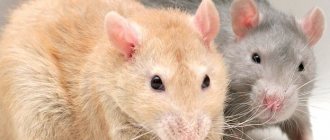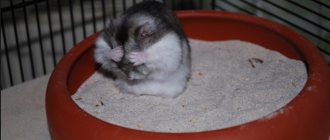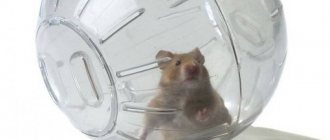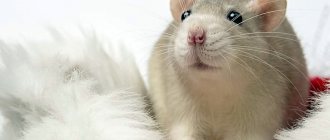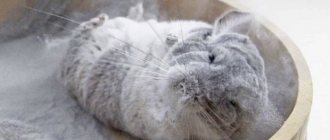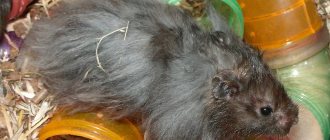- home
- Care
15.04.2018
Hamsters are very clean animals. They take care of their home, throwing garbage outside, and wash themselves often. To help the animal live clean, you can organize a special dry bath for it. Sand is very important for a hamster: in it the animal can clean its paws and fur from excess debris and fat.
Brands and types of sand for bathing
ATTENTION: Do not use the first sand you come across. It makes more sense to first get acquainted with the opinions of experts.
Normal from the sandbox
It is advisable to take ordinary river sand not from a sandbox, where its origin is unknown, but to bring it from the river. Before use, such sand must be washed, dried, and calcined in a frying pan or oven for disinfection. But in extreme cases, you can also use construction sand. It must be sifted, rinsed thoroughly with running water, calcined, and then sifted again.
Sand for parrots
Cleaning a bird's feathers and cleaning a hamster's delicate, thick fur are very different things. Sand intended for parrots contains various additives and impurities - crushed shells as a mineral supplement, activated carbon, etc. It is not suitable for hamsters .
Sand for chinchillas
Sand intended for chinchillas is generally suitable for hamsters. The sand should consist of quartz and sepiolite (meerschaum), not contain talc additives, and have round-shaped grains.
Volcanic sand
Volcanic sand is not really sand at all. This is a finely dispersed substance, a mixture of zeolite and aluminosilicates, its composition differs little from ordinary clay. Volcanic sand not only does not bring any benefit, but is simply harmful . When bathing, animals usually try to bury their heads, and as a result, they fill their eyes and ears with dust, and also inhale it. This can lead to severe respiratory problems.
Popular brands of sand for bathing a hamster
- Chinchilla sandy. Vitakraft, Germany. Expensive. Cleans fur perfectly and gives it shine. Packaging - 1 kg.
- Beaphar XtraVital Bathing Sand. Netherlands. Eliminates grease, moisture, ensures cleanliness and shine of the coat. Guaranteed to be dust free. Packaging – 1.3 kg.
- Padovan bathing send. Italy. Expensive. Guaranteed to be dust free. Packaged in 2 liter plastic packaging.
- Little one. Germany. Heat treatment guaranteed. Packaging - 1 kg.
- JR Farm. Bavaria. The grains of sand have a round shape, without sharp edges.
- Animals. "Zoomir", Russia.
- Waka Neat. Russia. Mentioned because of the low price.
What is a chinchilla bathing suit?
Many owners have no idea what a chinchilla bathing suit looks like and think that it is some kind of complicated contraption. In fact, any utensil, even an ordinary bowl, can become a bathing bowl.
The most common swimwear looks like this:
Bathing suit material: plastic or ceramic. Ceramic ones are usually more expensive, but they are a great choice because they are very beautiful.
The bathing suit is sold in almost every pet store and costs only 300-400 rubles. Usually it consists of 2 parts. The lower part, into which sand is poured, and the upper transparent lid, which prevents sand from splashing out of the bathing suit, and also makes it easy to wash and change the sand at the bottom. If the roof is not transparent, then it may be too dark there and the animal may not like this activity.
House bathing suits have also appeared on the market, but there is no fundamental difference in them from ordinary bathing suits. Therefore, choose according to your taste.
A chinchilla can bathe directly on the floor, the main thing is to add sand. The main disadvantage of such bathing is that the animal scatters sand throughout the room, so there must be walls that prevent it from scattering.
Choosing sand for hamsters
Bathing sand, which is sold in pet stores, must have the following properties:
- purity and uniformity of structure;
- average grain size;
- non-toxic;
- cleaning properties, ability to adsorb fat;
- ability to absorb moisture and unpleasant odors well;
- natural bactericidal properties, preventing the development of bacteria and fungi;
- environmental friendliness;
- hypoallergenic;
- should not create dust.
What can I use instead of bathing mixture for chinchillas?
An alternative to purchased sand can be homemade sand for bathing chinchillas. Volcanic or coral sand is ideal for these purposes, but they are extremely difficult to find. You can use river water, but only the smallest fraction. You should not take regular construction sand along roads or from playgrounds.
Sand for bathing chinchillas
Before use, sand must be prepared:
- remove all debris from it and rinse thoroughly;
- bake in the oven and let cool;
- add a few teaspoons of medical sulfur to prevent parasites and talc - improves moisture absorption, makes the sand more crumbly.
This bathing mixture is a significant financial savings for those who have many individuals living with them. If there is only one animal, it is more advisable to use purchased options.
Purchase of sand
The price of different brands of sand can vary significantly. Not only quality plays a significant role, but also the manufacturer’s brand. You should carefully study the composition of the filler, and everything else that is usually indicated in small print.
You should not make large reserves of filler unless absolutely necessary.
REFERENCE: A pack of filler weighing 1 kg for Djungarian hamsters normally lasts for about six months, for Syrian hamsters – for 3-4 months.
How chinchillas “wash”
Typically, cleanliness is associated with water and cleaning products. Some pets are actually washed in water with a special shampoo. But in the case of a chinchilla, the situation is different. These animals “wash” in volcanic sand. Under no circumstances should it be replaced with regular river sand. This can cause irreparable harm to the animal, because regular sand contains a lot of bacteria. In the wild, it is volcanic dust that animals use to thoroughly clean their entire undercoat. In addition, it perfectly absorbs excess moisture from fur.
Real volcanic dust is sold in specialized pet stores. It must be hermetically packaged and not sold in bulk. Unfortunately, the quality of the product can only be checked after unpacking. If the dust has a shine, then it contains quartz particles that will spoil the fur. Good volcanic dust is matte and leaves a powdery feel on the palm. There are no scratching particles in it.
This substance is poured into a bathing suit for chinchillas in a layer of 5-6 cm. The bathing procedure is carried out once every 2-3 days. The time allowed for this is no more than an hour, depending on the activity of the individual. You cannot leave the bathing suit longer, otherwise the animal will go there to use the toilet. After each procedure, the sand is sifted and new sand is added. After 12-15 bathings, it is completely replaced with fresh one. You can add a little sulfur to it to prevent skin diseases. When changing sand, you need to wash and dry the bath thoroughly. Once a month it must be disinfected. Moisture must not get into the sand, because this can cause parasites to appear in it.
Bath for hamsters
The animal will not see much difference between a purchased bath and a home-made one, since the hamster, as a sensible animal, is not interested in the form, but exclusively in its content.
Brands of bathtubs
- Super Pet. Ceramic bath for dzhungarika. The bath is compact and durable. Since ceramics are too tough for a hamster, they will last a long time.
- Savic wellness batc. The bathtub is intended, judging by its size, for Syrian hamsters. Material: non-toxic plastic. Equipped with a removable top.
- Plastic bath. Suitable also as a permanent toilet. It has a length of 17 cm, that is, it is suitable for both Dzungarians and young Syrians.
- Super pet chinchilla bath house. A bathing house with an original design, reflected in the price.
Baths for sand bathing from improvised means
Perfect for:
- old soap dish - for Djungarian hamsters;
- deep ceramic bowl;
- food container;
- plastic jar;
- a sufficiently strong cardboard box, etc.
With some effort, you can select a suitable container with a lid, cut a hole in the side, and adapt a ladder. The bathtub should be approximately twice the size of the animal and of sufficient height .
The best material for swimwear
When choosing this item, the material from which the item is made is of great importance: the material must be non-toxic, durable and safe for the animal. Each material has a number of positive and negative features that are important for the rodent owner to consider.
Important. Sometimes you can find ready-made metal baths on sale, but they are considered the most impractical and inconvenient: such material is difficult to clean and scratches easily.
Glass
The glass product most often represents a separate container in which the animal is placed. This option allows you to observe the bathing process and easily remove your pet after completing the hygiene procedure.
Advantages:
- aesthetic appearance;
- glass is easy to clean and dries quickly;
- absence of sharp protrusions;
- does not absorb odors.
Flaws:
- sand can scratch the glass surface from the inside;
- an open top through which the animal can pour out the filler during washing.
Glass bathing suit looks aesthetically beautiful
Plastic
You can buy plastic baths at a pet store, make them yourself, or use existing household items as a rodent bath, for example, a small food storage container or a picnic container.
Advantages:
- availability;
- strength and durability;
- practicality - usually plastic bathing suits have a closed lid and a spacious entrance;
- ease of care for a platinum bathtub.
Flaws:
- A plastic container, as a rule, is quite light in weight, so the animal can turn it over.
Wooden
Wood is a natural material that a chinchilla will love: the pet can gnaw lightly on wooden baths, grinding down its teeth. In addition, the wooden product looks very original and presentable.
Pros:
- spectacular appearance;
- completely natural material;
- variety of models.
Minuses:
- fragility - wood can easily become unusable, especially when a pet tries to sharpen its teeth on such material;
- It is quite difficult to wash such a bathing suit;
- absorbs odors.
Ceramic
Many chinchilla owners prefer ceramic baths because of their practicality, beauty and safety. This item is easy to install in your pet’s house and easy to clean after bathing.
Pros:
- stability - ceramic bathing suits are quite heavy, so the animal will not turn them over;
- practicality - such a thing is easy to wash and dry;
- does not absorb odors;
- durability.
Minuses:
- sometimes there are models with an entrance that is too high, where it will be difficult for the pet to climb;
- the cost of such products can be quite high.
From plywood
Plywood options are good for their environmental friendliness and naturalness. In addition, you can easily make a plywood bath with your own hands.
Advantages:
- environmental friendliness;
- availability;
- original appearance.
Flaws:
- fragility;
- difficulty in cleaning the product;
- plywood can absorb unpleasant odors, which are very difficult to remove.
Reference . The best option for a pet chinchilla is a ceramic container, while the most affordable is a plastic or plywood container.
You can make a bathing suit with your own hands
Bathing a hamster in a sand bath
A natural bath for hamsters is sand. There is no need to specially “wash” them. A sand bath should be done 1-2 times a week. The hamster is very happy with the sand, quickly climbs into it and flounders with pleasure. After half an hour, the bath should be removed. Using a brush, remove any remaining sand from the wool.
Pros of sand baths:
- Maintaining hygiene.
- Entertainment and exercise.
- Grooming, removing naturally dead epidermis.
The disadvantages of sand baths appear if the bath is left for a long time. This:
- Overdrying of the skin.
- The hamster will turn the bathtub into a toilet and wallow in dirty sand.
Bathing suit made from improvised means
Some dishes are great for bathing chinchillas, which very often lie idle in every home.
A round aquarium is probably the most suitable container. Chinchillas bathe well in it and, thanks to the transparent walls, it is light in it. The aquarium is also easy to clean and its slippery walls allow her to tumble whenever she wants.
Great video where you can see a chinchilla swimming in an aquarium.
A simple 3-liter glass jar is also suitable if your animal is not huge. If you have a large chinchilla, then it is better to look for a 5-liter jar. But the jar will have to be placed on its side, so sand will constantly fly out of it. There are two options: put the swimsuit in a cage or look for something else.
If you don’t have an aquarium or a jar, you can use a regular basin made of plastic or iron. It is good for chinchillas because they swim there and run around at the same time. In addition, you can put 2-3 chinchillas in a basin at once and they will play with each other.
Is it possible to bathe a hamster in water?
It is strictly forbidden to wash your hamster in water (except in exceptional cases)! Swimming in water does not cause anything but panic and discomfort in hamsters.
Why you shouldn't bathe hamsters in water
Bathing in water is unacceptable for rodents, since evolutionarily they are not at all adapted to this procedure.
A hamster, while “washing itself,” is already able to remove most of the dirt on its own. Have you ever bathed your hamster in water?
Severe stress
Hamsters perceive water as something frightening and become stressed. When stressed, they behave restlessly, or, conversely, apathetically. The hamster dies from very severe stress. Stressed females may eat the young. It is necessary to remove the hamster, place it in a dark, secluded place, and allow it to calm down.
Hypothermia
Hypothermia leads to a cold. Place the hamster in a warm place, give a mixture of water and warm milk with honey. Give Enroxil drops (2 drops in the morning and evening for 10 days), immunomodulating drops Gamavit (2-3 drops). You can soak the pieces of bread with chamomile infusion. The hamster will disinfect its cheek pouches and oral cavity with them.
IMPORTANT! Medicines intended for humans should not be given to hamsters! Only a veterinarian can prescribe medications!
Violation of the protective layer of the skin
Water with shampoo washes away the protective fat layer from the skin. This disrupts the acid-base balance and leads to dermatitis, swelling, and itching. The animal is itching. Neglected cases lead to ulcers.
Injuries
Hamsters panic when bathing - they bite, break out, and can fall to the floor and injure themselves. The injured hamster is limited in its mobility (placed in a carrier) and kept there until recovery. If there is an open fracture, contact a veterinarian.
How to tell if your hamster is sick after bathing
The hamster sneezes, has a runny nose, discharge from the eyes, tousled fur, lethargy, and dirty genitals. The hamster closes its eyes, loses weight, refuses food, and does not drink.
Benefits of sand baths
All domesticated animals must be kept in conditions close to natural ones. How do wild hamsters clean their fur of excess fat and dirt? That's right - wallowing in the sand! This method of bathing is safe and enjoyable. Therefore, sand is very important for a hamster.
Here are the positive differences between sand baths and water procedures:
- after bathing in the sand, there is no need to dry the animal’s fur;
- During sand bathing and after the procedure, the body does not become hypothermic, therefore, the possibility of catching a cold is zero;
- bathing a hamster in dry litter does not cause fear or panic in the animal, quite the opposite: for rodents it is a very fun activity;
- sand for a hamster can also become a sporting activity.
As you can see, sand baths are very beneficial for your furry friend. But in order for the fur cleansing procedure to be safe, the sand must be selected correctly.
How to properly bathe a hamster?
- Water is slightly above room temperature.
- ONLY special zoo shampoos are used.
- Excessive foam is not allowed.
- Water and foam are not allowed to get on the muzzle.
- After soaping, the foam is immediately washed off.
- After bathing the hamster, dry it COMPLETELY, and only then release it from your hands.
How to wash Djungarian hamsters?
Djungarian hamsters tolerate water better. However, this procedure is stressful for them too.
In order not to cause unnecessary trouble, it is better to replace the bath by wiping with damp cotton pads or a baby wipe (without fragrances). After this, the hamster should be dried with a towel or a light hair dryer.
How to wash Syrian hamsters?
Syrian hamsters, especially long-haired ones, are washed under a gentle stream of water, quickly, and only if absolutely necessary. You can wipe them with damp wipes. It's good to give them a sedative first. Dry with a towel or hairdryer.
Bathing suit made of wood and plywood
To make a bathing suit from wood or plywood, you need to have special tools and materials, but I don’t see the point in it. It is not particularly practical, since wood absorbs all odors and moisture, so over time such a bathing suit may develop an odor.
I would also like to point out that the chinchilla moves very quickly in the bathing suit, and the plastic or glass walls glide perfectly and do not hinder their movement. Think for yourself which slide is easier to slide down in the summer, a plastic one or a wooden one?
This photo shows what kind of bathing suit you can make with your own hands. A square shape is not the best for a swimsuit, an oval or round shape is just right.
Alternative to water treatments
Since washing your pet is dangerous and stressful, a hamster bath is a good alternative. By their nature, these animals are very clean, so they themselves are able to clean their fur by tumbling in the sand.
Bathing rods for rodents are sold in pet stores, but you can make them yourself from cardboard, a food container, a soap dish and other available materials. They need to be filled with very fine dry sand, which will have to be changed weekly. It is better not to leave the sandy bathing suit in the cage all the time, because the animal is capable of knocking it over or playing whale there. By the way, pet stores also sell cages with balconies that you can use for a sand bath.
The indisputable advantage of bathing suits is their complete safety. They do not drive the tiny pet into a state of panic, they do not make the fur wet and there is absolutely no chance of catching a cold. Therefore, we advise you to arrange sand baths for the crunch every day, and water baths only in case of emergency.
How to get rid of dirt without water?
As noted above, the reason for bathing a dwarf must be serious. And in many cases, you can clean your pet without taking a “bath”:
- If you notice an unpleasant odor from the hamster’s habitat, then you should bathe the cage, not the hamster. Just change the bedding, thoroughly wash the accessories, clean the toilet area daily - and the unpleasant odor will disappear.
- If the dzhungarika seems dirty and greasy at six, or there are pieces of food or feces stuck to it, then there is no need to take water procedures. Sand baths will help cope with such contaminants.
- If candy, chewing gum or glue is tangled in a dzhungarik's fur, then it is enough to cut off the affected area of fur.
- If a rodent gets dirty with food and cannot deal with the contamination on its own, you can wipe its fur with a damp cloth or cotton swab.
Article on the topic: What to do if you are bitten by a hamster until you bleed
If skin diseases are present, many experienced rodent veterinarians will prescribe medications that do not require washing your pet. For example, sprays and injections.
Swimming in the sand is an excellent alternative to water treatments
Since bathing Syrian hamsters is problematic, caring owners wash them in sand. Actually, in natural conditions, this is exactly how rodents wash themselves.
- Perfectly cleanses the fur of stubborn dirt.
- It does not cause stress, but on the contrary, it gives pleasure to your pet.
- Unlike water, sand cannot harm the health of a rodent.
If you use sand, you won't have to worry about how to properly bathe your hamster without harming it. The process is simple and natural, and the pet gets nothing but pleasure from it. All you need to do:
- Pour sand into the container.
- Put it in a cage.
- Observe - the hamster will wash itself.
- After finishing bathing, remove the container, otherwise it will turn into an additional toilet.
Important: buy sand that is specifically designed for hamsters.
This is very important because this product undergoes a number of cleaning measures. Thanks to this, it is absolutely safe for the pet's health.
One more caveat: do not buy sand intended for cleaning chinchilla fur. It is too fine-grained, so it is unlikely to be able to properly clean the hamster’s fur. In addition, it can enter his respiratory tract, causing inflammation.
General requirements
For baths that are provided for bathing chinchillas, there are a number of requirements:
- The volume of the bathing suit is from five liters and above;
- the entrance to the container must correspond to the size of the animal;
- the more stable the chinchilla bathing vase, the safer it is for the animal to bathe in it;
- all sharp corners and notches at the entrance must be thoroughly sanded with sandpaper;
- The swimsuit should be securely fastened, especially if it is constantly in the cage.
Washing a rodent using cosmetic pads and wet wipes
In addition to classic bathing and sand, you can wash your pet using cotton pads and wet wipes. The disc is very simple to use: moisten it in water and rub it over the contaminated area with light stroking movements.
You need to use napkins the same way. But there is one important point here: they should not contain alcohol or any kind of chemical elements that can ruin the hamster’s fur and damage the skin. The ideal option is to wash with baby wipes.
As with bathing, after wiping with napkins or discs, the coat should be thoroughly dried with a towel. If this is not done, the pet may get sick.
On behalf of the entire hamster family, I express my gratitude for not throwing it into the bathtub! Or much worse...
